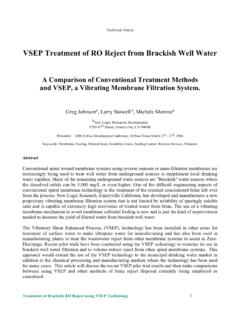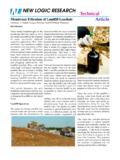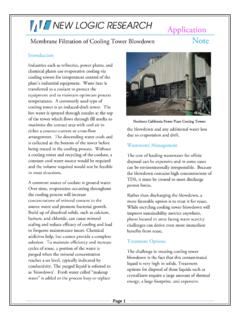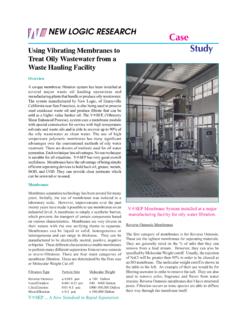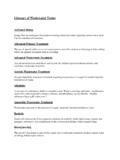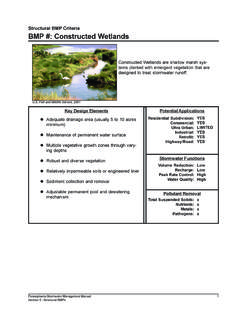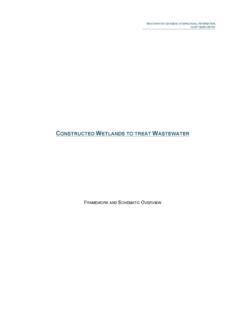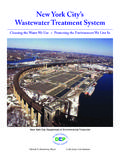Transcription of Abstract - VSEP
1 1 Evaluating Traditional and Innovative Concentrate treatment and Disposal Methods for Water Recycling at Big Bear Valley, California James C. Lozier, , CH2M HILL, Tempe, Arizona Ufuk G. Erdal, CH2M HILL, Santa Ana California Anne F. Lynch, CH2M HILL, Santa Ana California Steven Schindler , BBARWA, Big Bear, CA Abstract The Big Bear Area Regional Wastewater Agency (BBARWA) recently completed a study of advanced water reclamation as a means to augment existing potable water supplies for the residents and visitors of Big Bear Valley. Potable water is provided by local groundwater (GW); during periods of drought or prolonged dry weather water demand can exceed supply. The use of recycled water, treated to a high quality via an advanced treatment process and artificially recharged, has been identified as the best means of supplementing the native GW supply. The advanced treatment proposed at the BBARWA Facility consists of microfiltration (MF), reverse osmosis (RO), followed by ultraviolet disinfection (UV) with advanced oxidation.
2 While backwash waste produced from MF/UF facility can be recycled back to the headworks of the BBARWA wastewater treatment facility, the concentrate (reject) flow from the RO needs to be properly disposed. In this paper, seven different treatment methods were evaluated to dispose of concentrate from a future recycled water facility: constructed wetlands, electrodialysis reversal (EDR), enhanced RO treatment , mechanical and solar evaporation, Vibratory Shear Enhanced Process (VSEP) and wastewater effluent blending. All treatments were evaluated on a paper study basis, except VSEP, which was tested on-site using concentrate from the MF/RO pilot system. The study included siting solar evaporation and constructed wetlands facilities in Lucerne Valley 25 miles from BBV, where BBARWA currently land applies their wastewater effluent. LV was selected in this evaluation, because it minimizes public perception issues ( , mosquito, vector issues), reduces evaporation and wetland sizes due to higher evaporation/evapotranspiration rates in this lower altitude region and leaves space in WWTP for future plant expansion.
3 Study results showed the most cost effective approach is to combine RO concentrate volume reduction using VSEP or EDR with evaporation ponds or constructed wetlands in the LV. VSEP is preferred over EDR due to the ability to produce a high quality permeate that can be blended with BBARWA effluent and some fraction of RO concentrate while still meeting land application guidelines. constructed wetlands offer the potential to better management wildlife issues associated with elevated concentrations of selenium but have not been demonstrated to be sustainable using a zero liquid discharge approach. Introduction BBV lies approximately 100 miles east of Los Angeles and contains two major ski resorts serving southern California. Potable water is provided by local groundwater during periods of drought or prolonged dry weather demand can exceed supply. With no imported water available, the area is in need of other sources that will augment and provide a drought-proof, reliable, and locally controlled water supply.
4 Recycled water from the BBARWA Wastewater treatment Plant (WWTP) which treats average daily flow of mgd, has been identified as the best means of supplementing the native GW supply. Implementation of a groundwater recharge project would require the most advanced treatment available to ensure that no detrimental impacts occurred to the precious groundwater supply in the Valley. The advanced treatment proposed at the BBARWA Facility consists of MF/UF, RO and UV advanced oxidation using hydrogen peroxide. A (mgd) BBARWA ATF will produce approximately 160,000 gallons per day (gpd) of concentrate (reject) stream. The concentrate stream will require a proper means of disposal given it elevated salinity and organic content and potential presence of emerging contaminants of concern. This paper identifies options for RO concentrate management generated from the proposed BBARWA ATF. BBARWA has the option to construct concentrate disposal facilities ( , evaporation ponds or wetlands) in either the Big Bear Valley (within the existing BBARWA facility site) or in the Lucerne Valley on land that BBARWA owns.
5 A number of methods are available for disposal or reduction of concentrate. The following technologies were identified as feasible for application to concentrate disposal: 2 Solar evaporation constructed wetlands Electrodialysis reversal (EDR) Non-traditional reverse osmosis (RO), including Vibratory shear enhanced processing (VSEP) membrane treatment Enhanced membrane system (EMS) Blending with wastewater effluent Mechanical evaporation and crystallizer Discharge to surface water method was deemed infeasible because of the lack of perennial stream flow with sufficient capacity to assimilate the contaminants present in the concentrate. Deep well injection was also deemed not feasible in the Valley because of the geology of the area ( , the Valley is underlain with bedrock). Similarly, land application/irrigation was deemed not feasible due to the discharge limitations in Lucerne Valley.
6 Discharge limitations set by the Colorado River Basin RWQCB preclude direct application of RO concentrate onto the alfalfa fields in the Lucerne Valley. Irrigation of RO concentrate requires considerable treatment and blending with low chloride, TDS water, and a source of low chloride/TDS water is not available. The objective of this study is to identify technologies that could be used to develop multiple concentrate management alternatives that BBARWA could implement as part of advanced water reclamation and reuse, discuss specific implementation issues associated with each alternative, and develop associated capital and operation and maintenance (O&M) cost estimates to define life-cycle costs (LCC) for each alternative. This information was then used to develop and implement a decision analysis for concentrate management process selection. Methods and Approach RO Concentrate Water Quality A comprehensive pilot testing and sampling and analytical program was conducted at BBARWA in December 2005 to characterize water quality in the RO feed, permeate and concentrate streams.
7 A two-stage RO pilot facility was operated at an average flux of 11 gfd and recovery of 74 percent. Because the proposed ATF would be operated at 85 percent recovery, representative concentrate quality for 85 percent recovery operation were calculated using concentrate quality data from the pilot testing and the observed rejection of both TDS and individual ions.. The adjustment was accomplished by performing mass balance around the RO process assuming rejection rates for constituents were equivalent at 74 and 85 percent recovery assuming an equal flux. Mass Balances The selection of a concentrate management method depends on the projected quality and quantity of the concentrate from the proposed BBARWA ATF, site availability, cost, and regulatory issues. To meet regulatory requirements and minimize lifecycle costs, pretreatment scenarios were also considered in this analysis. For example, under some conditions, implementation of volume-reduction technologies prior to discharge to evaporation ponds can significantly reduce the size of the pond footprint.
8 Detailed mass balances were performed to estimate flows and water quality for each design scenario. An example mass balance is shown in Figure 1 below. 3 FIGURE 1 Flow Schematic and Chloride Mass Balance for VSEP-Evaporation Pond Concentrate Management Alternative Cost Estimates The level of detail in each of the cost estimates varied based on the amount of information available.. The preliminary cost estimates were generated using information obtained from technology vendors and from the CH2M HILL Parametric Estimating System (CPES). Planning-level (-30/+50 accuracy) cost estimates are provided herein. Conceptual design scenarios were then evaluated based on a life-cycle-cost (LCC) basis to provide impacts of both capital and O&M costs. The LCC are based on a 20-year life cycle period, with a percent discount rate (i) and a 3 percent of inflation rate (E). The life cycle cost relationship is shown in Equation (1) below.
9 ++ +=NiEEiEAP111*1+Capital Cost (1) Where: P: Present worth A: Annual O&M costs I: Discount rate ( ) E: Inflation rate (3%) N: Period (20 years) Evaluation of the Technologies Concentrate management alternatives applicable at the BBARWA facility can be categorized into three broad groups: Wastewater Effluent Mixing Volume Reduction Processes Zero Liquid Discharge Technologies (1) Wastewater Effluent Mixing Wastewater effluent mixing involves blending RO concentrate with treated wastewater effluent from a wastewater treatment plant to take advantage of the blending capacity of a lower-TDS stream to mitigate the 4 impact of the high TDS (or other solute) concentrate. The combined stream can then be discharged in accordance with existing permits or be applied to land. Currently, the treated wastewater from the BBARWA WWTP is discharged to alfalfa fields located in the Lucerne Valley via a 16-/18-inch cement-mortar-lined steel pipeline.
10 Due to strict chloride and TDS requirements in the BBARWA NPDES permit for this discharge, water quality rather than hydraulic capacity of the discharge pipeline will dictate the maximum allowable volume of RO concentrate that can be blended. Based on these limits, and the concentrations of chloride and TDS in the effluent, only 32,000 gallon per day (gpd) of RO reject could be blended with secondary wastewater effluent from the BBARWA WWTP while still satisfying the NPDES discharge permit. The mass balance and discharge requirements for wastewater effluent mixing design scenario are presented in Table 2. TABLE 2 Mass Balance and Discharge Requirements for Wastewater Effluent Mixing Parameter WWTP Discharge RO Concentrate Blended Stream of RO Concentrate and Treated Secondary Effluent Discharge Limit at Discharge Point No. 001 Flow, gpd 1,150,000a 32,000 1,182,000 4,500,000 BOD5, mg/L 17 Boron, g/L 240 835 250 750 Chloride, mg/L 343 Fluoride, mg/L TDS, mg/L 450 2,830 424 650c TSS.

